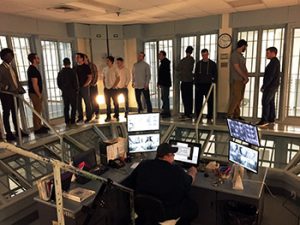Richard Paige — We weren’t 50 feet inside the dual fencing that surrounds the Wabash Valley Correctional Facility when the catcalls came from two inmates shooting baskets at outdoor hoops.
This had the makings of a very uncomfortable immersion experience.
The maximum-security facility in Carlisle, IN, was the destination for Assistant Professor of History Sabrina Thomas’ History of Mass Incarceration class. It was an opportunity for 18 students to step inside those 14-foot electrified fences topped by razor wire.
It was supposed to be a reality check.
“We are studying prisons, we are studying systems, theories and ideas,” Thomas said. “We’re looking at the prison objectively as academics, and we sometimes forget that this is a real thing with real people involved.”
From the maximum-security Restrictive Housing Unit (RHU), where inmates are escorted to and from cells by pairs of guards with handcuffs and leads, to the minimum-security J-House, where the dormitory style housing provided more smiles than anticipated, the students saw those inmates on their turf.
The tour included a visit to the PLUS unit (Purposeful Living Units Serve), a faith-based outreach program that provides hand-made quilts and clothing to the surrounding community, as well as a stop at the Educational Department, where one student got an impromptu lesson.

The RHU might have provided the most eye-opening experience. From their vantage point inside a security pod, the students could see four hallways of maximum-security cells, watch inmates transferred to and from, and get a peek inside those cells from the bank of video monitors on the guard’s desk.
It was an immediate lesson to the real impacts of prison, especially since the RHU was the first building on the tour, and just moments after those initial catcalls.
“It was powerful to see in real life,” said Evan Frank ’19. “It’s like caging people. They are able to obtain some access to the outside world if they are really fortunate, but they are completely isolated. They can’t do anything.”
Multiple times during the tour, we heard that prison is its own city. It’s no different than any other community. At times, admittedly, it felt like we were the center of attention on this tour. At times, it felt like prison tourism.
“Everything we’re talking about in class has real-life effects,” said Thomas. “There are human consequences. (The tour) definitely humanized the idea of incarceration. “It may have humanized it a bit too much.”